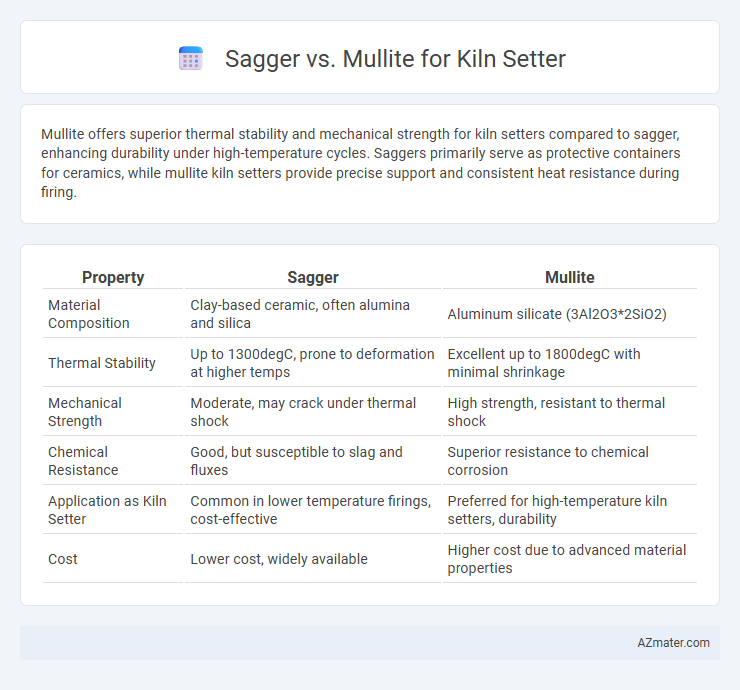Mullite offers superior thermal stability and mechanical strength for kiln setters compared to sagger, enhancing durability under high-temperature cycles. Saggers primarily serve as protective containers for ceramics, while mullite kiln setters provide precise support and consistent heat resistance during firing.
Table of Comparison
| Property | Sagger | Mullite |
|---|---|---|
| Material Composition | Clay-based ceramic, often alumina and silica | Aluminum silicate (3Al2O3*2SiO2) |
| Thermal Stability | Up to 1300degC, prone to deformation at higher temps | Excellent up to 1800degC with minimal shrinkage |
| Mechanical Strength | Moderate, may crack under thermal shock | High strength, resistant to thermal shock |
| Chemical Resistance | Good, but susceptible to slag and fluxes | Superior resistance to chemical corrosion |
| Application as Kiln Setter | Common in lower temperature firings, cost-effective | Preferred for high-temperature kiln setters, durability |
| Cost | Lower cost, widely available | Higher cost due to advanced material properties |
Introduction to Kiln Setters: Sagger vs Mullite
Kiln setters are critical components in high-temperature kiln operations, with saggers and mullite being two common materials used due to their thermal properties. Saggers, typically made from refractory clay, provide excellent protection for ceramics by shielding them from direct flame and ash contamination, while mullite offers superior thermal shock resistance and structural integrity at elevated temperatures. Choosing between saggers and mullite depends on specific firing requirements, including temperature range, durability, and chemical interactions within the kiln environment.
Composition and Material Properties
Sagger materials typically consist of high-purity fireclay or refractory clay with alumina content ranging from 40% to 60%, providing excellent thermal shock resistance and protection against glaze defects in kiln firings. Mullite, with a higher alumina content of approximately 72% and silica around 28%, exhibits superior refractoriness, mechanical strength, and low thermal expansion, making it more durable under prolonged high-temperature exposure in kiln setters. The enhanced thermal stability and corrosion resistance of mullite over sagger clay offer improved performance for kiln setter applications, especially in demanding firing cycles.
Thermal Resistance Comparison
Mullite offers superior thermal resistance compared to sagger, withstanding temperatures up to 1750degC while maintaining structural integrity, making it ideal for kiln setters in high-temperature firing processes. Saggers typically tolerate temperatures around 1300degC to 1450degC but may degrade faster under prolonged thermal stress, impacting kiln setter durability. The enhanced thermal stability and lower thermal expansion of mullite minimize cracking and deformation, providing more reliable performance in kiln setter applications.
Mechanical Strength and Durability
Mullite exhibits superior mechanical strength and durability compared to saggers when used as kiln setters, due to its high thermal stability and resistance to thermal shock. Mullite's low thermal expansion and excellent creep resistance enhance the longevity and structural integrity of kiln setters under extreme firing conditions. Saggers, typically made from less refractory materials, are more prone to wear and deformation, reducing their effectiveness in maintaining consistent kiln atmospheres.
Weight and Handling Considerations
Mullite kiln setters are significantly lighter than sagger setters, reducing strain during installation and maintenance. The lower density of mullite enhances handling efficiency, especially in high-capacity or frequent-change kiln environments. Weight reduction improves safety and decreases labor costs in industrial kiln operations.
Performance in Various Firing Environments
Sagger and mullite materials exhibit distinct performance traits in various firing environments, with mullite offering superior thermal stability and resistance to thermal shock, making it ideal for high-temperature kiln setter applications. Sagger, often composed of clay and alumina, provides effective protection against kiln atmospheres but may degrade faster under extreme thermal cycles compared to mullite. Mullite's low thermal expansion and high refractoriness contribute to its extended lifespan and enhanced support during rapid temperature fluctuations in industrial kilns.
Cost Analysis and Longevity
Sagger materials typically offer lower initial costs compared to mullite but tend to have shorter lifespans due to lower thermal stability and higher susceptibility to chemical corrosion in kiln environments. Mullite, with its superior thermal shock resistance and chemical durability, justifies higher upfront expenses through extended service life and reduced replacement frequency, making it more cost-effective in long-term kiln setter applications. When evaluating total cost of ownership, mullite kilns setters demonstrate better value by minimizing downtime and maintenance costs over multiple firing cycles.
Impact on Product Quality
Sagger and mullite play crucial roles in kiln setter applications, directly influencing product quality through thermal stability and contamination prevention. Sagger, typically made from refractory clay or alumina, provides a protective barrier that minimizes direct heat impact and chemical interactions, ensuring consistent firing results. Mullite's superior thermal expansion resistance and durability enhance kiln setter lifespan, reducing defects associated with warping or material breakdown under high-temperature conditions.
Maintenance and Cleaning Requirements
Sagger materials like clay or ceramic require frequent inspection and cleaning due to their porous nature, which can accumulate residue and cause contamination in kiln processes. Mullite, a refractory material rich in alumina and silica, offers superior durability and resists chemical attack, resulting in less frequent maintenance and simpler cleaning routines. Mullite's high thermal stability and resistance to thermal shock reduce crack formation, prolonging kiln setter lifespan and minimizing downtime for cleaning and repairs.
Choosing the Right Material for Your Kiln Setter
Choosing the right material for your kiln setter is crucial for durability and thermal efficiency, where both sagger and mullite offer distinct advantages. Mullite provides high thermal shock resistance and mechanical strength, making it ideal for repeated high-temperature cycles, while sagger offers superior protection against contamination and direct flame exposure. Evaluating factors such as kiln atmosphere, firing temperature, and the specific application will guide the optimal choice between sagger and mullite to enhance kiln setter performance and longevity.

Infographic: Sagger vs Mullite for Kiln Setter
 azmater.com
azmater.com